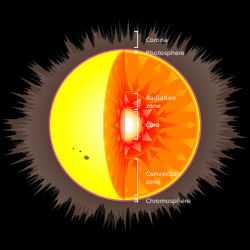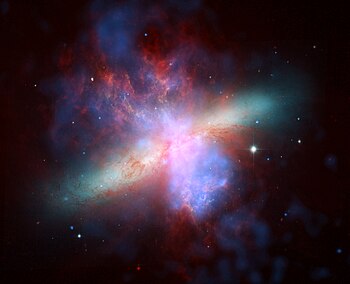

Portal maintenance status: (June 2018)
|
The Stars Portal
Introduction
Image of the Sun, a G-type main-sequence star, the closest to Earth Astar is a luminous spheroidofplasma held together by self-gravity. The nearest star to Earth is the Sun. Many other stars are visible to the naked eye at night; their immense distances from Earth make them appear as fixed points of light. The most prominent stars have been categorised into constellations and asterisms, and many of the brightest stars have proper names. Astronomers have assembled star catalogues that identify the known stars and provide standardized stellar designations. The observable universe contains an estimated 1022to1024 stars. Only about 4,000 of these stars are visible to the naked eye—all within the Milky Way galaxy. A star's life begins with the gravitational collapse of a gaseous nebula of material largely comprising hydrogen, helium, and trace heavier elements. Its total mass mainly determines its evolution and eventual fate. A star shines for most of its active life due to the thermonuclear fusion of hydrogen into helium in its core. This process releases energy that traverses the star's interior and radiates into outer space. At the end of a star's lifetime as a fusor, its core becomes a stellar remnant: a white dwarf, a neutron star, or—if it is sufficiently massive—a black hole. Stellar nucleosynthesis in stars or their remnants creates almost all naturally occurring chemical elements heavier than lithium. Stellar mass lossorsupernova explosions return chemically enriched material to the interstellar medium. These elements are then recycled into new stars. Astronomers can determine stellar properties—including mass, age, metallicity (chemical composition), variability, distance, and motion through space—by carrying out observations of a star's apparent brightness, spectrum, and changes in its position in the sky over time. Stars can form orbital systems with other astronomical objects, as in planetary systems and star systems with twoormore stars. When two such stars orbit closely, their gravitational interaction can significantly impact their evolution. Stars can form part of a much larger gravitationally bound structure, such as a star cluster or a galaxy. (Full article...) Selected star - show another
Photo credit: ESO/P. Kervella Betelgeuse is a semiregular variable star located approximately 640 light-years from the Earth. With an apparent magnitude ranging between 0.3 and 1.2, it is the ninth brightest star in the night sky. Although Betelgeuse has the Bayer designation Alpha Orionis (α Orionis / α Ori), it is most often the second brightest star in the constellation Orion behind α; Rigel (Beta Orionis) is usually brighter (Betelgeuse is a variable star and is on occasion brighter than Rigel). The star marks the upper right vertex of the Winter Triangle and center of the Winter Hexagon. Betelgeuse is a red supergiant, and one of the largest and most luminous stars known. For comparison, if the star were at the center of the Solar System its surface might extend out to between the orbits of Mars and Jupiter, wholly engulfing Mercury, Venus, the Earth and Mars. The angular diameter of Betelgeuse was first measured in 1920–1921 by Albert Abraham Michelson and Francis G. Pease using the 100 inch (2.5 m) John D. Hooker astronomical interferometer telescope atop Mount Wilson Observatory. Astronomers believe Betelgeuse is only a few million years old, but has evolved rapidly because of its high mass. Due to its age, Betelgeuse may go supernova within the next millennium (because it is hundreds of light years away, it possibly may have done so already). Selected article - show another
Photo credit: User:Werothegreat and User:Sakurambo The main sequence is a continuous and distinctive band of stars that appear on plots of stellar color versus brightness. These color-magnitude plots are known as Hertzsprung-Russell diagrams after their co-developers, Ejnar Hertzsprung and Henry Norris Russell. Stars on this band are known as main-sequence stars or "dwarf" stars. After a star has formed, it creates energy at the hot, dense core region through the nuclear fusionofhydrogen atoms into helium. During this stage of the star's lifetime, it is located along the main sequence at a position determined primarily by its mass, but also based upon its chemical composition and other factors. All main sequence stars are in hydrostatic equilibrium, where outward thermal pressure from the hot core is balanced by the inward gravitational pressure from the overlying layers. The strong dependence of the rate of energy generation in the core on the temperature and pressure helps to sustain this balance. The main sequence is sometimes divided into upper and lower parts, based on the dominant process that a star uses to generate energy. Stars below about 1.5 times the mass of the Sun (or 1.5 solar masses) primarily fuse hydrogen atoms together in a series of stages to form helium, a sequence called the proton-proton chain. Above this mass, in the upper main sequence, the nuclear fusion process mainly uses atoms of carbon, nitrogen and oxygen as intermediaries in the CNO cycle that produces helium from hydrogen atoms. Energy generated at the core makes its way to the surface and is radiated away at the photosphere. The energy is carried by either radiationorconvection, with the latter occurring in regions with steeper temperature gradients, higher opacity or both. Main sequence stars with more than ten solar masses undergo convection in the core region, which acts to stir up the newly created helium and maintain the proportion of fuel needed for fusion to occur. When core convection does not occur, a helium-rich core develops surrounded by an outer layer of hydrogen. For stars with lower masses, this convective core is progressively smaller until it disappears at about 2 solar masses. Below this mass, stars have cores that are radiative but are convective near the surface. With decreasing stellar mass the convective envelope increases, and main sequence stars below 0.4 solar masses undergo convection throughout their mass. Selected image - show another
Photo credit: NASA Messier 82 (also known as NGC 3034, Cigar Galaxy or M82) is the prototypenearby starburst galaxy about 12 million light-years away in the constellation Ursa Major. The starburst galaxy is five times as bright as the whole Milky Way and one hundred times as bright as our galaxy's center. M82 was previously believed to be an irregular galaxy. However, in 2005, two symmetric spiral arms were discovered in the near-infrared (NIR) images of M82, and is now considered a spiral galaxy. Did you know?Subcategories
To display all subcategories click on the ►
Selected biography - show another
Photo credit: State Post Bureau of the People's Republic of China Zhang Heng (simplified Chinese: 张衡; traditional Chinese: 張衡; pinyin: Zhāng Héng; Wade–Giles: Chang Heng) (CE 78–139) was a Chinese astronomer, mathematician, inventor, geographer, cartographer, artist, poet, statesman and literary scholar from Nanyang, Henan. He lived during the Eastern Han Dynasty (CE 25–220) of China. He was educated in the capital cities of Luoyang and Chang'an, and began his career as a minor civil servant in Nanyang. Eventually, he became Chief Astronomer, Prefect of the Majors for Official Carriages, and then Palace Attendant at the imperial court. His uncompromising stances on certain historical and calendrical issues led to Zhang being considered a controversial figure, which prevented him from becoming an official court historian. His political rivalry with the palace eunuchs during the reign of Emperor Shun (r. 125–144) led to his decision to retire from the central court to serve as an administrator of Hejian, in Hebei. He returned home to Nanyang for a short time, before being recalled to serve in the capital once more in 138. He died there a year later, in 139. Zhang applied his extensive knowledge of mechanics and gears in several of his inventions. He invented the world's first water-powered armillary sphere, to represent astronomical observation; improved the inflow water clock by adding another tank; and invented the world's first seismometer, which discerned the cardinal direction of an earthquake 500 km (310 mi) away. Furthermore, he improved previous Chinese calculations of the formula for pi. In addition to documenting about 2,500 stars in his extensive star catalogue, Zhang also posited theories about the Moon and its relationship to the Sun; specifically, he discussed the Moon's sphericity, its illumination by reflecting sunlight on one side and remaining dark on the other, and the nature of solar and lunar eclipses. His fu (rhapsody) and shi poetry were renowned and commented on by later Chinese writers. Zhang received many posthumous honors for his scholarship and ingenuity, and is considered a polymath by some scholars. Some modern scholars have also compared his work in astronomy to that of Ptolemy (CE 86–161).
TopicsWikiProjects
Things to do
Related portals
Associated WikimediaThe following Wikimedia Foundation sister projects provide more on this subject:
Commons
Wikibooks
Wikidata
Wikinews
Wikiquote
Wikisource
Wikiversity
Wiktionary
Discover Wikipedia using portals
|